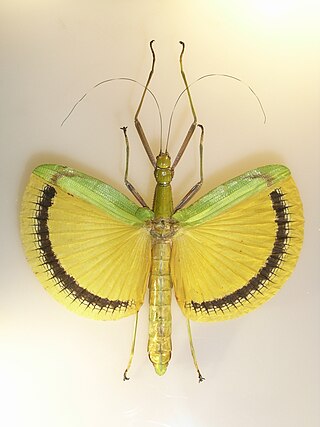Mnesilochus is a genus of stick insects in the subfamily Lonchodinae. Species have a known distribution in: Borneo, Philippines, Sumatra.

Phobaeticus is a genus of Asian stick insects comprising over 25 species. The genus includes some of the world's longest insects.

Necrosciinae is a subfamily of the stick insect family Lonchodidae, with its greatest diversity in South-East Asia.

Ramulus is an Asian genus of stick insects in the family Phasmatidae and tribe Clitumnini.

Bacillidae is a stick insect family in the order Phasmatodea and the suborder Verophasmatodea.

Sipyloidea is a genus of stick insects of the family Lonchodidae. Species have been recorded from India, China, Indochina, through to Australasia. The genus was described by Brunner von Wattenwyl in 1893.

Aschiphasmatidae are a family of stick insects belonging to the suborder Verophasmatodea; they can be found in Indomalaya.

The Heteropterygidae is a family of stick insects belonging to the suborder Euphasmatodea. Species can be found in Australasia, East and Southeast Asia. More than 130 valid species have been described.
Dajaca is a genus of stick insects belonging to the suborder Verophasmatodea, family Aschiphasmatidae and is the only representative of the monotypic tribe Dajacini. Species have been recorded from Borneo, Vietnam, Hong Kong and Myanmar.

Marmessoidea is an Asian genus of stick insects in the family Lonchodidae and subfamily Necrosciinae. The native range of species appears to be from India and South-East Asia to the Wallace line.

Lopaphus is an Asian genus of stick insects in the tribe Necrosciini. Species have been recorded from India, China and South-East Asia.

Pylaemenes is a genus of stick insects in the family Heteropterygidae and subfamily Dataminae. It combines small to medium-sized, often brightly colored Phasmatodea species. Their representatives are found in large parts of Southeast Asia.

The Clitumninae are a sub-family of stick insects in the family Phasmatidae found in Asia. The type genus Clitumnus is now considered a synonym of Ramulus.

The Lonchodinae are a subfamily of stick insects in the family Lonchodidae found in: Australasia, Asia, Africa, Southern America and the Pacific.

The Gratidiini are a tribe of stick insects based on the type genus Clonaria and first used by Cliquennois in 2005. Genera are known to be distributed in: Africa, Europe, temperate and tropical Asia and various Pacific Islands.

The Obriminae are the most species-rich subfamily of the Phasmatodea family Heteropterygidae native to Southeast Asia. It is divided into two tribe.
Entoria is a genus of stick insects in the tribe Clitumnini, erected by Carl Stål in 1875. Species have been recorded from: China, Japan, Indochina and the Philippines.
Rhamphophasma is a genus of stick insects in the tribe Clitumnini, erected by Carl Brunner von Wattenwyl in 1893. Species have been recorded from: China, Vietnam, India, Myanmar and Japan.

Neohirasea is a genus of stick insects in the tribe Necrosciini, erected by J.A.G. Rehn in 1904. Species has been recorded from temperate and tropical Asia, including: China, India, Japan, Malaysia and Vietnam.
Planososibia is a genus of Asian stick insects in the tribe Necrosciini, erected by Francis Seow-Choen in 2016. Species have been recorded from: Sri Lanka, Tibet, China, Vietnam and Malesia.















